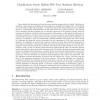64 search results - page 11 / 13 » Zero-One Frequency Laws |
MOBISYS
2003
ACM
14 years 7 months ago
2003
ACM
Wireless local-area networks are becoming increasingly popular. They are commonplace on university campuses and inside corporations, and they have started to appear in public area...
OOPSLA
2005
Springer
14 years 1 months ago
2005
Springer
It is now well established that the device scaling predicted by Moore’s Law is no longer a viable option for increasing the clock frequency of future uniprocessor systems at the...
TOIS
2008
13 years 7 months ago
2008
Many valuable text databases on the web have non-crawlable contents that are "hidden" behind search interfaces. Metasearchers are helpful tools for searching over multip...
DAC
2008
ACM
14 years 8 months ago
2008
ACM
The computer industry has a problem. As Moore's law marches on, we will be exploiting it to double cores, not frequencies. But all those cores ... 2 to 4 today growing to 8, ...
ASUNAM
2009
IEEE
14 years 2 months ago
2009
IEEE
—We envision new communication paradigms, using physical dynamic interconnectedness among people. Delay Tolerant Networks (DTNs) are a new communication paradigm to support such ...

